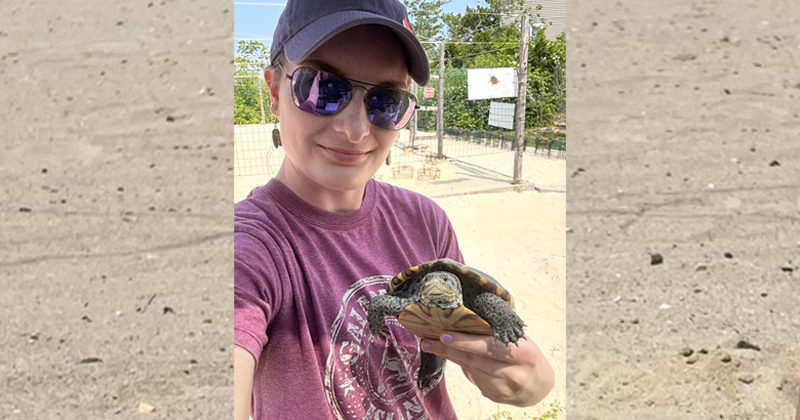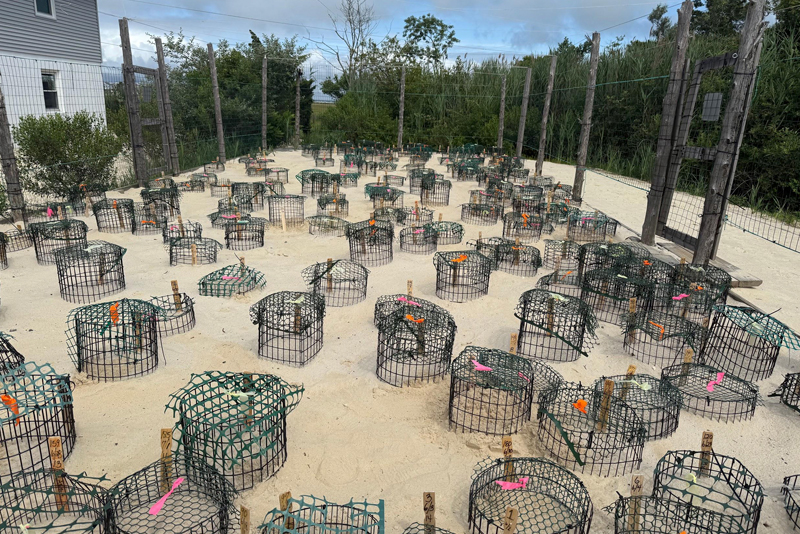


Tracking tidal turtles
Photos courtesy of Samantha Melanson | Photo illustration by Jeffrey C. Chase August 06, 2025
UD senior studies diamondback terrapin nesting habits in Barnegat Light, NJ
Editor’s note: Every year, hundreds of undergraduates at the University of Delaware pursue research under the guidance of a faculty mentor, especially during the summer months. Such experiences provided by UD — a nationally recognized research university — can be life-changing, introducing young scholars to a new field, perhaps even the path to a future career, as they uncover new knowledge. These spotlights offer a glimpse into their world.
Diamondback terrapins are a native turtle species that live in brackish coastal tidal marshes. Their name refers to the diamond-shaped pattern found on their upper shell, known as the carapace.
Found exclusively in estuaries — bodies of water where freshwater rivers meet the ocean—diamondback terrapins emerge from the water in early summer to lay clutches of eggs on sandy beaches from Cape Cod, Massachusetts, to the Florida Keys. They do not stay with the nest, however; instead, they return to tidal waters once the eggs are laid. Eggs mature and hatch late summer to early fall.
Diamondback terrapins contribute to a healthy marsh ecosystem by eating periwinkle snails, fiddler crabs and other species that can damage marsh grasses. Yet, these tidal turtles face increasing challenges as infrastructure expansion along coastlines encroaches on their nesting sites and environmental changes reshape the shoreline landscape. Predation from raccoons, crows and other animals also contribute to species vulnerability.

University of Delaware senior Samantha Melanson, a wildlife ecology and conservation major, is studying the behavior and nesting habits of the terrapin at an outdoor research site located in her hometown of Barnegat Light, New Jersey. The research site is a sandy lot created by the Terrapin Nesting Project, a nonprofit organization that has been helping rebuild terrapin populations for over 10 years. Melanson is working with Mimi Purzycki, the site’s founder. She is advised at UD by Jeffrey Buler, professor of wildlife ecology.
Q: Why did you want to pursue this? What intrigues you about the topic?
Melanson: I wanted to work with the terrapins because, as a species, I find them to be so interesting! Terrapins are native to the East Coast, and they have a nesting site in Barnegat Light, New Jersey, where I’m from. When I first moved to the island, I noticed terrapins crossing the roads, and I would always stop traffic to help them, which led me to wonder about their behavior. The way that they continue to survive despite the ever-growing urban expansion of Long Beach Island is so inspiring, and I find it fascinating how they will return to their hatching spot year after year. I wanted to learn more about the species.
Q: Why does research like this matter?
Melanson: This research is important to better understand the environment and the wildlife that lives within it. By working with their nests, helping the terrapins survive and monitoring their survival, we are also improving the marshland, as terrapins are known to eat invasive species like periwinkle snails. Overall tracking and documenting terrapin species growth also matters, as it can show if the restoration program is successful.
Q: What does your daily research/work entail?
Melanson: Every day I drive to the nesting site at 9 a.m. to check if there are terrapins currently nesting, as well as if there are any tracks in the sand. Mimi will arrive at that time as well. We then monitor the roads right next to the site. On a typical sunny day, we would have terrapin activity, but if there is cloud cover or rain, we generally would not get any terrapins. Once a terrapin is done nesting, I will pick her up and take her measurements and weight. I measure the length and width of the terrapin’s carapace (the upper shell), plastron (bony bottom plate) and height. I also assess the turtle for any damage and scan her with a microchip reader. I record the microchip number, time of nesting, the weather and the location where the terrapin was found or if they naturally walked up to our site. Each terrapin gets a microchip and a name. Mimi has the training and the permit to microchip terrapins that arrive without one.
Once I process a terrapin’s data, I bring her back to the marsh where she emerged. Then I find the nest and dig a trench around it, placing a cage over top to stop predation. Normally, the terrapins stop arriving around noon, but it can vary a lot. Some days we trench nests until 5 p.m. Each day is a little different in the field!

Q: What happens to the data you collect?
Melanson: Once the nesting season ends mid-July, I will run statistical analysis on the data I’ve been collecting. I am interested in seeing the terrapins' overall age distribution, range and if the weather or time of day has an impact on when they nest. Since the terrapins can come up to the nest site up to three times per season, it will be interesting to see if there is a significant change in the terrapin’s weight between each nest. This type of information can provide data about the health of an individual terrapin and can inform what is known about the species overall.
Q: What’s the coolest thing about being involved in this project? Have you had any surprising or especially memorable experiences?
Melanson: The coolest thing about this project is gaining a better understanding of the terrapins’ personalities. For example, I have found that first-year terrapins are often small and shy. They hide in their shells and get spooked easily. But terrapins that have been coming for years seem to be familiar with us and will try to scratch, bite and wiggle away at every opportunity. It's our job to make sure they are safe and not stressed out while we handle them. Getting to know terrapins who are repeat visitors has been a lot of fun. A specific memorable experience for me was watching a terrapin walk up to the site, noticing she had a bump on her shell and immediately saying, “Oh, it’s Charisma!” before even seeing her up close. Charisma is a terrapin who has been coming to the site for years. She survived a boat strike and now has a stunning scar on her shell, which I recognized right away. It is neat to pick up on how each terrapin is just a little different.
Q: Is there anything you've discovered about yourself and your career goals as you've worked on the project?
Melanson: Because of the location, there are a lot of tourists who see the research site and wonder what we are doing. I have found that I really enjoy educating the public who come up to the site and ask questions about the terrapins. At first, I was nervous, but I've become more comfortable. Because of this, I can see myself going into education in the future and teaching others the importance of protecting and conserving our native species. Next spring I will earn my bachelor of science degree in wildlife ecology and conservation, followed by a master’s degree in May 2027 through the 4+1 program for wildlife environmental education.
Q: What do you enjoy doing in your spare time?
Melanson: In my spare time, I enjoy birding at the beach and fishing in the bay. I also enjoy playing board games and video games with my friends and family. After working with the terrapins, I like to relax by drawing and working on art projects.

Contact Us
Have a UDaily story idea?
Contact us at ocm@udel.edu
Members of the press
Contact us at mediarelations@udel.edu or visit the Media Relations website

